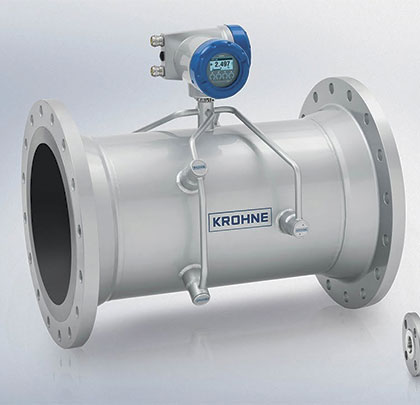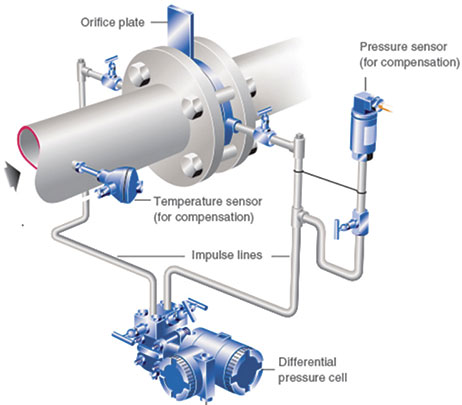Renewable energy poses well-publicized opportunities in the quest to reduce fossil fuel consumption and global warming. However rarely mentioned are the new challenges associated with increasingly more frequent startups, shutdowns and load changes on conventional power plants. An increasingly variable production rate is necessary to balance the dynamic nature of renewable energy production which can be influenced each day by the availability of sunlight or wind, for example.
One specific new challenge is the measurement of steam flow during these dramatic power boiler load changes. This challenge will grow as the amount of renewable electrical energy in the grid increases in relation to the amount of electricity generated by power boilers using traditional fuels.
HIGH PRESSURE STEAM FLOW MEASUREMENT REQUIREMENTS
Steam flow measurement in an environment of increasingly faster and more frequent load changes and startups/shutdowns necessitates flowmeters that can operate accurately in a stable manner at increasingly lower flow rates when steam demand for conventional energy production is low and at high flow rates when demand for conventional energy is high. Stated differently, these flowmeters must measure accurately over a wider turndown and be capable of a more dynamic response than would otherwise be required without renewable electrical energy generation sources. In addition, these flowmeters must be reliable, safe to operate and easy to maintain.
Benefits of more accurate steam flow measurements include the ability to better monitor the process and identify problems sooner. In particular, these steam measurements can be used to determine whether or not equipment is functioning properly and efficiently—enabling corrective action well before there is a major problem or economic impact. Accurate steam flow measurements also contribute to the ability of power boilers to reach steady state operation faster and better follow demand so as to provide more stable and more economical operation. In addition, better monitoring and control results in a safer operation.
Typical applications where steam flow is measured in power plants include steam production from the boiler or heat recovery steam generator and steam used for injection, turbines, heat exchangers, and other auxiliary equipment.
Differential pressure, mechanical, vortex shedding, and ultrasonic flowmeters are often applied in high pressure steam service. The extreme operating conditions to which these flowmeters are exposed make their maintenance an important factor in selecting which flowmeter to apply.
Improved high pressure steam flow measurement can be used in conjunction with feed water, condensate, and/or fuel flowmeters to more precisely monitor power boiler performance and enable more efficient operation under startup conditions and at loads below their rated minimum capacity. This wider operational capability can yield substantial energy savings and potentially reduce the number of startup and shutdowns required during operation. Reducing the number of startups and shutdowns not only reduces operator activity but also tends to reduce overall equipment maintenance requirements.
Therefore, existing flow measurement systems based on old measurement techniques should be considered for upgrade or replacement when maintenance becomes too costly or cumbersome.
Figure 1: Differential pressure flow element installation in high pressure steam service (image courtesy of Spirax Sarco).
DIFFERENTIAL PRESSURE STEAM FLOWMETERS
Differential pressure flow measurement systems are estimated to represent approximately 90 percent of the population of flowmeters used to measure high pressure steam. This has been the case historically because few other flowmeter technologies are sufficiently rugged to withstand high steam pressures and high steam temperatures.
The primary differential pressure flow element is a physical restriction located in the pipe that generates a pressure drop proportional to the square of the flow rate. Primary elements come in many forms, but flow nozzles or orifice plates are the most common in steam service. The pressure drop is measured using a differential pressure transmitter. Pressure and temperature measurements are often added in applications where operating conditions vary significantly or when the steam is superheated to more accurately calculate the mass flow.
Despite having “worked” in power plants for decades, differential pressure flow measurement systems have a number of significant constraints:
The relationship between flow and pressure drop is inherently non-linear whereby a small differential pressure change at low flow results in a large flow change. In particular, 0 and 1 percent of differential pressure correspond to 0 to 10 percent of flow. As a result, a seemingly small differential pressure error at low flow can result in relatively large flow errors that can significantly degrade flow measurement accuracy and limit the turndown of the flow measurement system.
The uncertainty of the primary flow element must be considered to determine the overall differential pressure flow measurement system performance. Improper geometry and/or material selection can cause the primary flow element to wear and/or become deformed over time. Some differential pressure flowmeter primary flow elements (such as an orifice plates) can be installed with an offset from the center of the pipe that can cause unnoticed but substantial flow measurement errors. Perhaps as concerning is that many of these flowmeters cannot be removed from service to check for wear or deformation without a 100 percent shutdown—that may not come for decades (literally). Any damage that can affect accuracy may only be discovered years or even decades later. Even primary flow elements that can theoretically be isolated could be a problem when steam shutoff valves do not seal properly.
The restriction in the pipe causes a non-recoverable pressure drop that reduces the energy content of the stream and therefore reduces the amount of energy that can is available to make electricity
Impulse tubes route the upstream and downstream pressures from the primary flow element to a differential pressure transmitter and/or indicator. In older plants, these devices were often located near the control room for convenience—often 50+ meters from the primary flow element. Any imbalance in the impulse lines caused by ambient conditions, perhaps from poor insulation, may result in a bias error on the measurement. Aside from the possibility of a leak, even short impulse tubes can cause potentially unsafe conditions. For most fluids, removing the transmitter from service involves opening a bypass valve and closing shutoff valves. In power plant steam service, this procedure may cause the liquid seals to be drained and expose the transmitter sensor to high temperature steam which may damage it. The more ominous danger from an impulse tube fitting failure or valve mishandling is the potential for serious or critical injury to the technician from the steam.
Differential pressure transmitter performance is affected by the ambient pressure and temperature at which the transmitter operates. Pressure and temperature effect specifications can often appear deceivingly small but may be actually be multiples of the transmitter accuracy at high process pressures and at varying temperatures, especially for older transmitters.
Differential pressure transmitter specifications are almost always directly or indirectly based on a fixed differential pressure error at the optimal sensor range maximum—not a flow rate error. The significance of this differential pressure error becomes bigger as flow is reduced. Further exacerbating the measurement error is the aforementioned non-linear relationship between flow and differential pressure. The differential pressure errors at low flow end up as even larger flow errors. In particular, consider an application where measuring over a 10:1 turndown would be beneficial. Here, a seemingly appropriate transmitter with a (differential pressure) turndown of 25:1 represents a flow turndown of only 5:1 (20-100 percent flow). This fixed differential pressure error degrades performance significantly at low flow rates. In other words, the desired flow turndown is not achieved.
Any available diagnostics are limited to the operation of the differential pressure transmitter.
In summary, differential pressure flow measurement systems will “work” for a long time—but they do have issues of concern insofar as their maintenance and safety, performance, turndown, and overall accuracy.
A LOOK AHEAD
In part 2, we’ll take a closer look at mechanical steam flowmeters, vortex shedding steam flowmeters, and—finally—ultrasonic steam flowmeters, in addition to a brief synopsis of maintenance issues. Ultimately, IF your plant uses older metering technology for steam or other flow measurements, this discussion should help to optimize your process operations.
Günter Pinkowski serves as director of marketing for Krohne, Inc., a world-leading manufacturer and supplier of solutions in industrial process instrumentation. Krohne offers supporting products and services for one-stop-shopping and in industries as widespread as oil and gas, water and wastewater, chemical and petrochemical, food and beverage, power, minerals, and mining and marine. For more information, visit www.krohne.com.
_______________________________________________________
MODERN PUMPING TODAY, March 2018
Did you enjoy this article?
Subscribe to the FREE Digital Edition of Modern Pumping Today Magazine!
![]()



